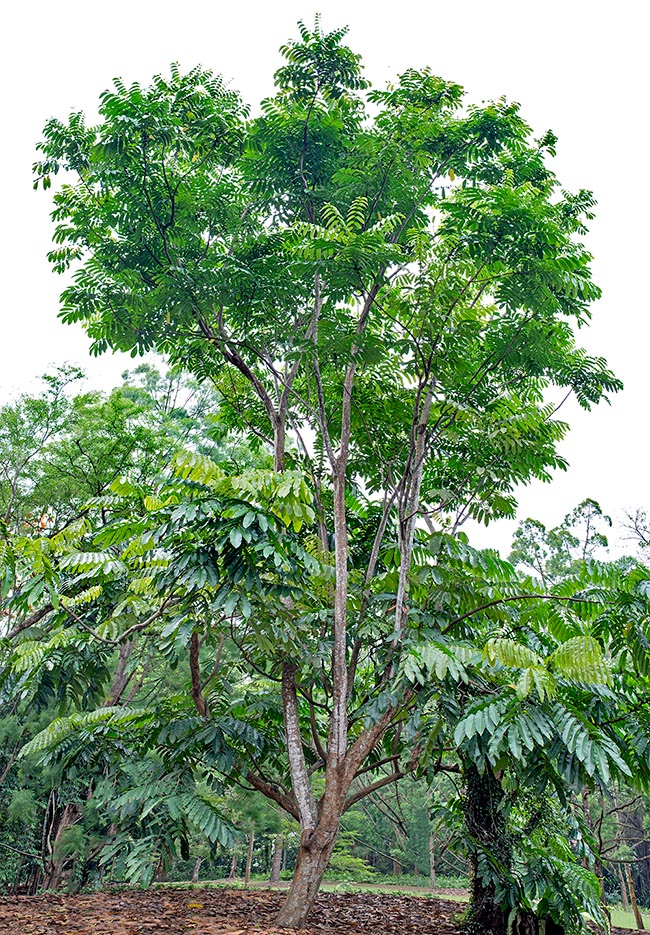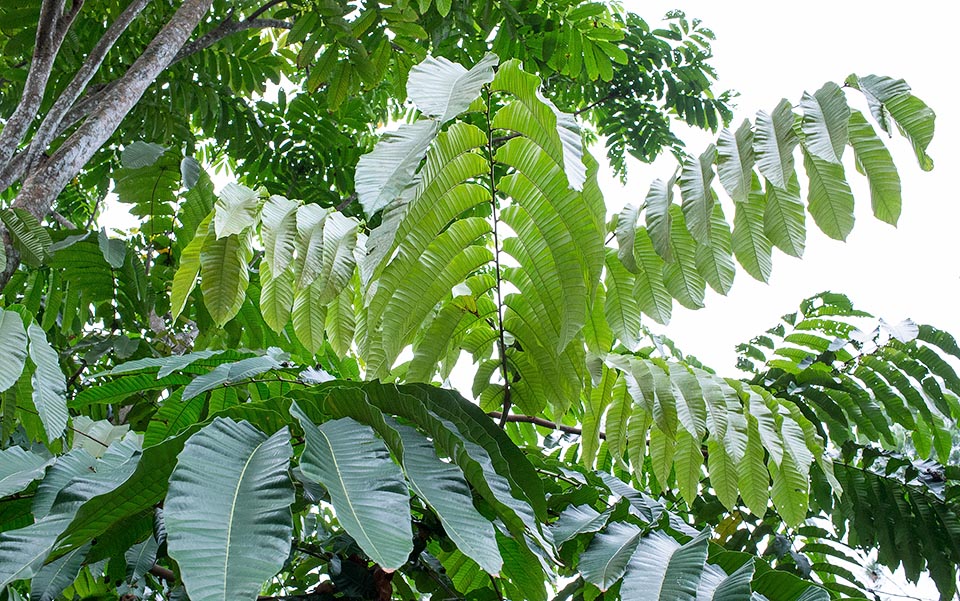Family : Sapindaceae

Text © Pietro Puccio

English translation by Mario Beltramini

Native to South-East Asia and part of Oceania, Pometia pinnata can be 50 m tall © Giuseppe Mazza
The genus is honoured to the French botanist Pierre Pomet (1658-1699); the specific name is the Latin adjective “pinnatus, a, um” = fledged, winged, with reference to the pinnate leaves.
Common names: Fijian longan, island lychee kasai, megan, oceanic lychee (English); fan long yan shu (China); ndawa, tawa (Fiji); agupanga, malugai, tugaui (Philipines); kasai, matoa, sibu (Indonesia); tava (Salomon Islands); matoa, obahu, taun (Papua New Guinea); kava, tava (Samoa); daeng-nàam (Thailand); tava, tava moli (Tonga); nandao, natsaria, nendo, rao, tava (Vanuatu); truong, truong maat (Vietnam).
The Pometia pinnata J.R. Forst. & G. Forst. (1775) is a very variable monoecious tree 35-50 m tall in the old specimens in nature, with cylindrical trunk, of more than 1 m of diameter, provided at the base of tabular roots (flat roots similar to buttresses), and yellowish brown to reddish bark from whose wounds exudes a red resin. Leaves alternate, paripinnate, up to 1,2 m long, formed by 4-16 couples of sub-opposite leaflets, the first couple urbicular, about 3 cm long, the following ones oblong with serrate margin, pointed apex and parallel lateral veins, 15-35 cm long and 5-12 cm broad, coriaceous, of glossy intense green colour above, pale green below; the young leaves are pink to reddish brown and tomentose. Panicle inflorescences terminal or axillar usually erect, 20-70 cm long, bearing unisexual flowers present at the same time, each one with vestigial organs of the other sex. Campanulate calyx, with 5 lobes about 1 mm long, obovate-triangular petals of whitish geen colour, 2 mm long, male flowers with 5 prominent stamina, 4-6 mm long, and red or yellow anthers, female flowers with bilobed bilocular ovary, pubescent, and style about 5 mm long. Indehiscent fruit ellipsoid or subglobose with more or less thin pericarp greenish yellow to glossy blackish brown, depending on the variety, 3-5 cm long and of 2-4 cm of diameter, containing only one globose seed, 2-2,5 cm long and of about 1,5 cm of diameter, oily, partially surrounded by an aril white to slightly pinked, translucid, of pleasant and delicate taste.
It propagates by seed, without the aril, and interred as soon as taken off from the fruit, having a short lasting germinability, if not duly conserved, in perfectly draining organic loam maintained humid at the temperature of 24-26 °C; it reproduces also by cutting.
Fast growing species particularly diffused in the forests of the Pacific Ocean islands, where at times represents the dominant species, often cultivated in the family gardens and close to the villages, in order to reduce the transportation times of its fruits towards the markets, being the same quickly perishable. Besides the pulp, consumed fresh, also the seed is at times consumed boiled or roasted.

Fast growing species with very decorative leaves and edible fruits. Bark and leaves are used in the traditional medicine. Laboratory studies are underway © G. Mazza
The wood, of pink colour tending to reddish if exposed to the light, averagely heavy and resistant, easy to work and refine, is utilized, locally as well as exported, for inner parts of the dwellings, for boats, furniture, boxes and common use objects, moreover, it is excellent to burn and to produce charcoal.
Bark and leaves are employed in the origin zones in the traditional medicine for various pathologies; laboratory studies have evidenced in the bark and in the wood the presence of compounds with anti-oxidant properties worthy of further studies.
Synonyms: Irina tomentosa Blume (1825); Pometia tomentosa (Blume) Teijsm. & Binn. (1886); Pometia pinnata fo. tomentosa (Blume) Jacobs (1962).
→ To appreciate the biodiversity within the SAPINDACEAE family please click here.
